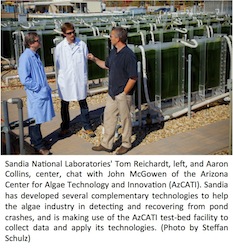Sandia National Laboratory has developed several complementary technologies to help the algae industry in detecting and recovering from pond crashes, and is  making use of the AzCATI test-bed facility to collect data and apply its technologies. The research focuses on monitoring and diagnosing algal pond health and draws upon Sandia’s longstanding expertise in microfluidics technology, its strong bioscience research program and significant internal investments.
making use of the AzCATI test-bed facility to collect data and apply its technologies. The research focuses on monitoring and diagnosing algal pond health and draws upon Sandia’s longstanding expertise in microfluidics technology, its strong bioscience research program and significant internal investments.
According to researchers, because of the way algae is grown and produced in most algal ponds, they are prone to attack by fungi, rotifers, viruses or other predators. Consequently, algal pond collapse is a critical issue that companies must solve to produce algal biofuels cost-effectively. The issue was identified as a key component in the Department of Energy’s National Algal Biofuels Technology Roadmap.
To address the problem, Sandia is addressing the algal pond crash issue in three complementary ways:
- Developing a real-time monitoring tool for algal ponds that can detect indications of a problem days in advance of a crash;
- Successfully applying pathogen detection and characterization technologies honed through the lab’s Rapid Threat Organism Recognition (RapTOR) work; and
- Employing its innovative SpinDx diagnostic device to dig deeper into problems after they’ve occurred and help to identify specific biological agents responsible for crashes.
Sandia’s Tom Reichardt, a researcher who works in the lab’s remote sensing unit, led development of an online algal reflectance monitor through an internally funded project. The instruments are typically set up alongside the algal pond, continuously monitoring, analyzing the algae’s concentration levels, examining its photosynthesis and performing other diagnostics.
“In real-time, it will tell you if things are going well with the growth of your algae or whether it’s beginning to show signs of trouble,” said Reichardt. However, he cautioned, while this real-time monitoring will warn pond operators when the ponds have been attacked, it may not be able to identify the attacker. He notes that quick identification of organisms in ponds is the key to mitigation.
Now that the core principles of pathogen detection and characterization technologies for pond crash forensics have been successfully proven, the next step for the team will be to conduct more robust demonstrations. The research team will be continuing their work as part of the Algae Testbed Public-Private Partnership (ATP3) led by Arizona State University (ASU), the first national algae testbed. The Sandia team will apply the technologies, collect more data and seek additional collaborations.

